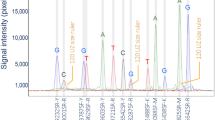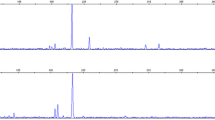Abstract
We performed a population study on 15 polymorphic STR loci (FH2010, FH2079, PEZ2, VWF.X, FH2054, FH2087Ub, FH2611, WILMS-TF, PEZ12, PEZ15, PEZ6, FH2087Ua, ZUBECA4, ZUBECA6, FH2132) on 131 randomly selected dogs. Alleles were identified and grouped according to their estimated fragment length using fixed allelic bins encompassing one base-pair. The allele assignment was confirmed by sequence analysis of homozygote and cloned heterozygote alleles. In order to develop a uniform repeat-based nomenclature, extensive sequence analysis was performed on a selection of alleles from each STR locus. The proposed nomenclature refers to the internationally recognised recommendations for human-specific STR loci in forensic applications. The 15 canine-specific STR loci were grouped into 3 classes (simple STRs, compound STRs and complex/hypervariable STRs) according to their complexity and variability within the repeat structure. Finally, we evaluated the precision of fragment size estimation on a capillary electrophoresis platform and demonstrated reproducibility of fragment length estimation for single base-pair intermediate alleles.















Similar content being viewed by others
References
Wayne RK (1993) Molecular evolution of the dog family. Trends Genet 9:218–224
Flagstad O, Walker CW, Vila C et al. (2003) Two centuries of the Scandinavian wolf population: patterns of genetic variability and migration during an era of dramatic decline. Mol Ecol 12:869–880
Vila C, Savolainen P, Maldonado JE et al. (1997) Multiple and ancient origins of the domestic dog. Science 276:1687–1689
Vila C, Maldonado JE, Wayne RK (1999) Phylogenetic relationships, evolution, and genetic diversity of the domestic dog. J Hered 90:71–77
Vila C, Walker C, Sundqvist AK et al. (2003) Combined use of maternal, paternal and bi-parental genetic markers for the identification of wolf-dog hybrids. Heredity 90:17–24
Wayne RK, Ostrander EA (1999) Origin, genetic diversity, and genome structure of the domestic dog. Bioessays 21:247–257
De Munnynck K, Van de Voorde W (2002) Forensic approach of fatal dog attacks: a case report and literature review. Int J Legal Med 116:295–300
Muller S, Flekna G, Muller M, Brem G (1999) Use of canine microsatellite polymorphisms in forensic examinations. J Hered 90:55–56
Padar Z, Egyed B, Kontadakis K, Furedi S, Woller J, Zoldag L, Fekete S (2002) Canine STR analyses in forensic practice. Observation of a possible mutation in a dog hair. Int J Legal Med 116:286–288
Shutler GG, Gagnon P, Verret G, Kalyn H, Korkosh S, Johnston E, Halverson J (1999) Removal of a PCR inhibitor and resolution of DNA STR types in mixed human-canine stains from a five year old case. J Forensic Sci 44:623–626
Savolainen P, Rosen B, Holmberg A, Leitner T, Uhlen M, Lundeberg J (1997) Sequence analysis of domestic dog mitochondrial DNA for forensic use. J Forensic Sci 42:593–600
Schneider PM, Seo Y, Rittner C (1999) Forensic mtDNA hair analysis excludes a dog from having caused a traffic accident. Int J Legal Med 112:315–316
Ichikawa Y, Takagi K, Tsumagari S et al. (2001) Canine parentage testing based on microsatellite polymorphisms. J Vet Med Sci 63:1209–1213
Padar Z, Angyal M, Egyed B, Furedi S, Woller J, Zoldag L, Fekete S (2001) Canine microsatellite polymorphisms as the resolution of an illegal animal death case in a Hungarian zoological gardens. Int J Legal Med 115:79–81
Padar Z, Egyed B, Kontadakis K, Zoldag L, Fekete S (2001) Resolution of parentage in dogs by examination of microsatellites after death of putative sire: case report. Acta Vet Hung 49:269–273
Zajc I, Sampson J (1996) DNA microsatellites in domesticated dogs: application in paternity disputes. Pflugers Arch 431:R201–202
Zajc I, Mellersh C, Kelly EP, Sampson J (1994) A new method of paternity testing for dogs, based on microsatellite sequences. Vet Rec 135:545–547
Zajc I, Sampson J (1999) Utility of canine microsatellites in revealing the relationships of pure bred dogs. J Hered 90:104–107
Bär W, Brinkmann B, Budowle B, Carracedo A, Gill P, Lincoln P, Mayr W, Olaisen B (1997) DNA recommendations. Further report of the DNA Commission of the ISFH regarding the use of short tandem repeat systems. International Society for Forensic Haemogenetics. Int J Legal Med 110:175–176
Gill P, Kimpton C, d’Aloja E et al. (1994) Report of the European DNA profiling group (EDNAP)—towards standardisation of short tandem repeat (STR) loci. Forensic Sci Int 65:51–59
Gill P, Brinkmann B, d’Aloja E et al. (1997) Considerations from the European DNA profiling group (EDNAP) concerning STR nomenclature. Forensic Sci Int 87:185–192
Gill P, Brenner C, Brinkmann B et al. (2001) DNA Commission of the International Society of Forensic Genetics: recommendations on forensic analysis using Y-chromosome STRs. Int J Legal Med 114:305–309
Walsh PS, Metzger DA, Higuchi R (1991) Chelex 100 as a medium for simple extraction of DNA for PCR-based typing from forensic material. Biotechniques 10:506–513
Dolf G, Schlapfer J, Switonski M, Stranzinger G, Gaillard C, Schelling C (1998) The highly polymorphic canine microsatellite ZuBeCa4 is localized on canine chromosome 3q15-q18. Anim Genet 29:403–404
Dolf G, Schelling C, Stahlberger-Saitbekova N, Fu B, Schlapfer J, Yang F (2000) Seven cosmid-derived canine microsatellites. Anim Genet 31:411–412
Francisco LV, Langston AA, Mellersh CS, Neal CL, Ostrander EA (1996) A class of highly polymorphic tetranucleotide repeats for canine genetic mapping. Mamm Genome 7:359–362
Holmes NG, Dickens HF, Parker HL, Binns MM, Mellersh CS, Sampson J (1995) Eighteen canine microsatellites. Anim Genet 26:132–133
Holmes NG, Dickens HF, Neff MW, Mee JM, Sampson I, Binns MM (1998) Nine canine microsatellites. Anim Genet 29:477
Jonasdottir TJ, Dolf G, Sletten M et al. (1999) Five new linkage groups in the canine linkage map. Anim Genet 30:366–370
Ladon D, Schelling C, Dolf G, Switonski M, Schlapfer J (1998) The highly polymorphic canine microsatellite ZuBeCa6 is localized on canine chromosome 5q12-q13. Anim Genet 29:466–467
Neff MW, Broman KW, Mellersh CS et al. (1999) A second-generation genetic linkage map of the domestic dog, Canis familiaris. Genetics 151:803–820
Ostrander EA, Sprague GF Jr, Rine J (1993) Identification and characterization of dinucleotide repeat (CA)n markers for genetic mapping in dog. Genomics 16:207–213
Richman M, Mellersh CS, Andre C, Galibert F, Ostrander EA (2001) Characterization of a minimal screening set of 172 microsatellite markers for genome-wide screens of the canine genome. J Biochem Biophys Methods 47:137–149
Shibuya H, Collins BK, Huang TH, Johnson GS (1994) A polymorphic (AGGAAT)n tandem repeat in an intron of the canine von Willebrand factor gene. Anim Genet 25:122
Shibuya H, Collins BK, Collier LL, Huang TH, Nonneman D, Johnson GS (1996) A polymorphic (GAAA)n microsatellite in a canine Wilms tumor 1 (WT1) gene intron. Anim Genet 27:59–60
Tiret L, Kessler JL, Bentolila S, Faure S, Bach JM, Weissenbach J, Panthier JJ (2000) Assignation of highly polymorphic markers on a canine purebred pedigree. Mamm Genome 11:703–705
Butler J (2001) Forensic DNA typing: biology & technology behind STR markers. Academic Press, San Diego, pp 53–81
Sgueglia JB, Geiger S, Davis J (2003) Precision studies using the ABI prism 3100 genetic analyzer for forensic DNA analysis. Anal Bioanal Chem 376:1247–1254
Urquhart A, Kimpton CP, Downes TJ, Gill P (1994) Variation in short tandem repeat sequences—a survey of twelve microsatellite loci for use as forensic identification markers. Int J Legal Med 107:13–20
Acknowledgements
The authors would like to thank Mag. vet. med. Volker Büchele, Helena and Paul Scheithauer for bravely collecting the samples. Harald Niederstaetter is kindly acknowledged for valuable discussion.
Author information
Authors and Affiliations
Corresponding author
Rights and permissions
About this article
Cite this article
Eichmann, C., Berger, B. & Parson, W. A proposed nomenclature for 15 canine-specific polymorphic STR loci for forensic purposes. Int J Legal Med 118, 249–266 (2004). https://doi.org/10.1007/s00414-004-0452-5
Received:
Accepted:
Published:
Issue Date:
DOI: https://doi.org/10.1007/s00414-004-0452-5




